No matter where you live, you can grow aloe vera indoors. But what if you want to plant it out in the garden?
If you’re located in USDA Hardiness Zones 9-11, you’re in luck – you can add this beautiful, beneficial succulent to your yard.
For more history, background, and full cultivation instructions for growing aloe vera, check out our guide.
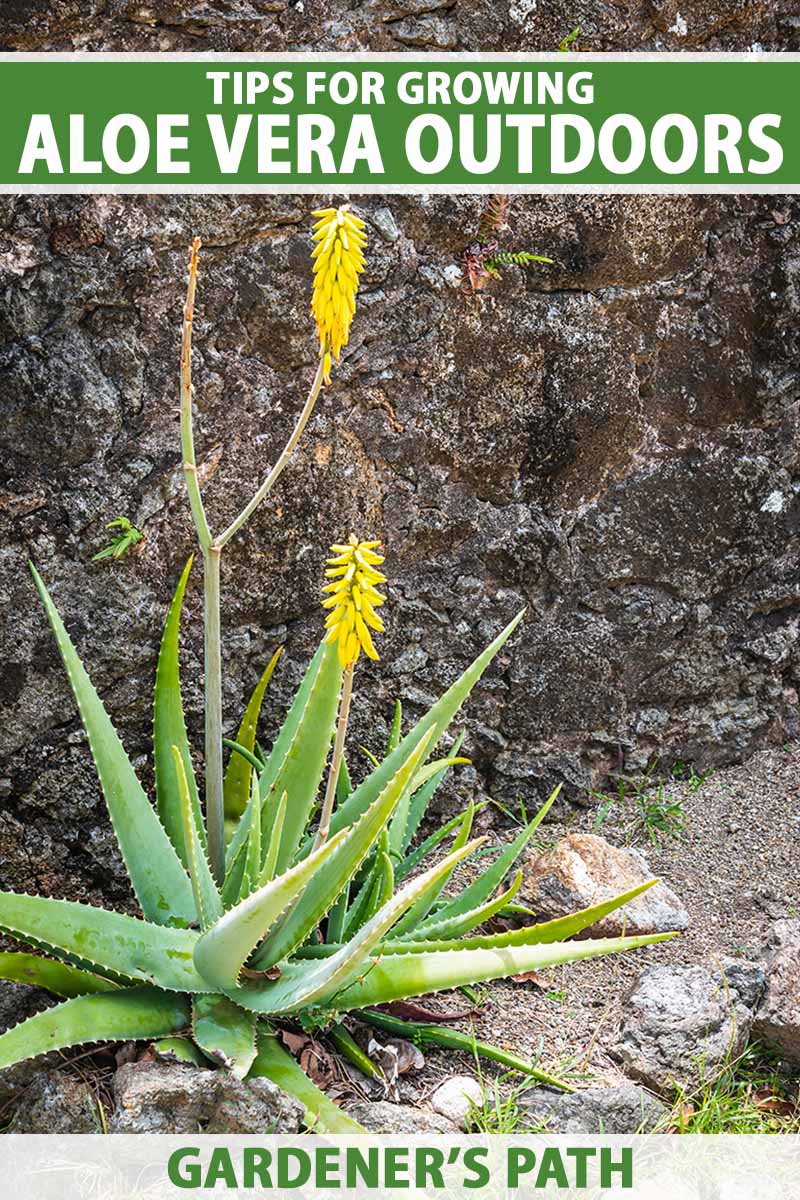
We link to vendors to help you find relevant products. If you buy from one of our links, we may earn a commission.
This article will cover how to grow the spiky succulent outdoors specifically, and why you might want to.
Here’s what we’ll discuss:
What You’ll Learn
An Aloe Primer
Aloe vera is a member of the Asphodelaceae family, which includes asphodel and red-hot poker plants (Kniphofia spp).

This plant is famous for the gel inside the succulent leaves, which has soothed many a minor burn throughout history. The long, spiky leaves grow 24-39 inches long from a short stem.
If you grow this succulent outdoors, you can reap the benefits of the soothing gel. And thanks to this gel, aloe vera requires very little water to grow.
Actually called the “mesophyll” layer of the leaf, the gel supplies moisture to the aloe between waterings.
Thanks to this exceptional level of drought tolerance, aloe vera makes an excellent addition to a low-water garden or xeriscape. You can also grow it in lieu of low shrubs to adorn your foundation plantings, or place it in window boxes for a pleasing effect.
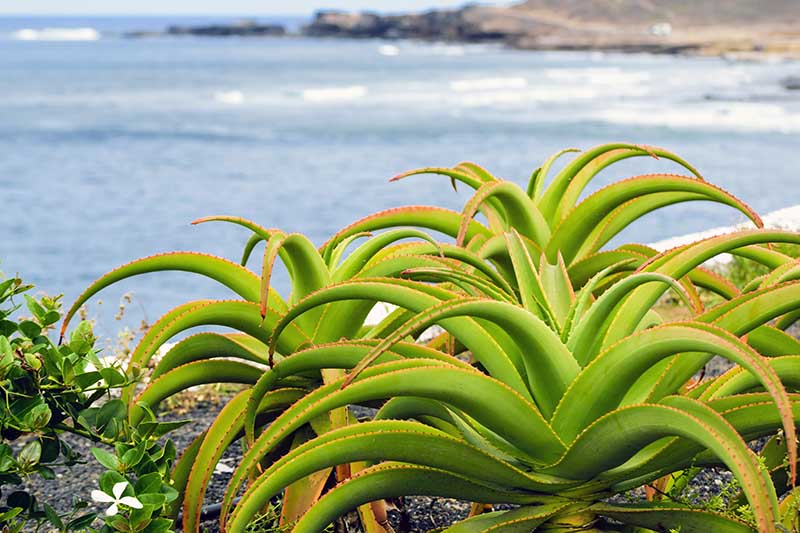
Since aloe can be cultivated indoors year-round, you may be wondering what the advantage of growing it outdoors could be.
Besides being an excellent option for xeriscaping in drought-prone and desert climates, there’s an added bonus: Flowers.
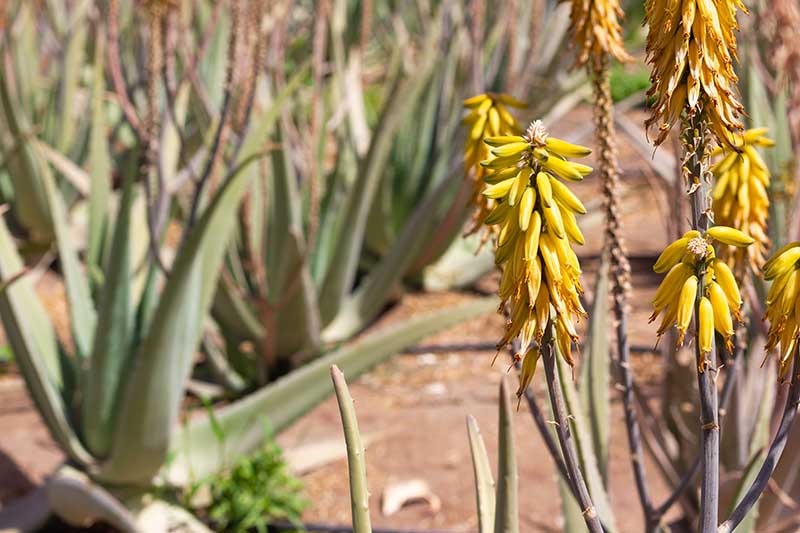
That’s right. Aloe vera grown indoors doesn’t receive enough sunlight to produce flowers.
But grow it outdoors and you’ll enjoy the yellow blossoms that burst from a spike that rises from the center of the plant in the summer months, and periodically throughout the year
How to Grow
For outdoor planting, first choose an area of your yard or garden that receives between four and six hours of full sun.
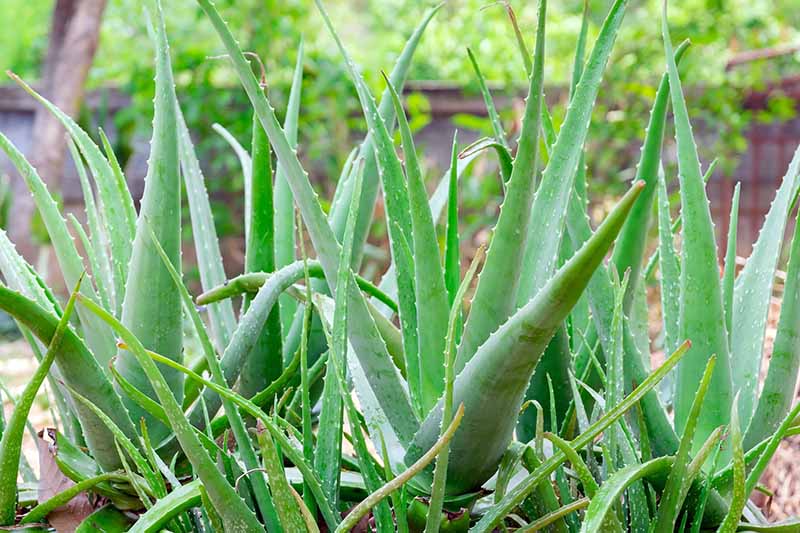
The amount of sunlight depends on your climate: for those who live near the coast or at sea level, it’s fine to give the aloe six hours.
But if you live in an arid, inland desert with an elevation of 1,000 feet above sea level or higher, you may want to provide just four hours: aloe doesn’t care for too much of the intense sunlight it’ll receive at higher elevations.
Too much direct sunlight can burn the leaves, turning them a bronze color.
If you’re having a tough time finding a location that only receives four to six hours of sunlight, you could always have a shade cloth handy and put it over the plant during the middle of the day, when the sun is at its most intense. This will help keep the leaves from getting sunburned.
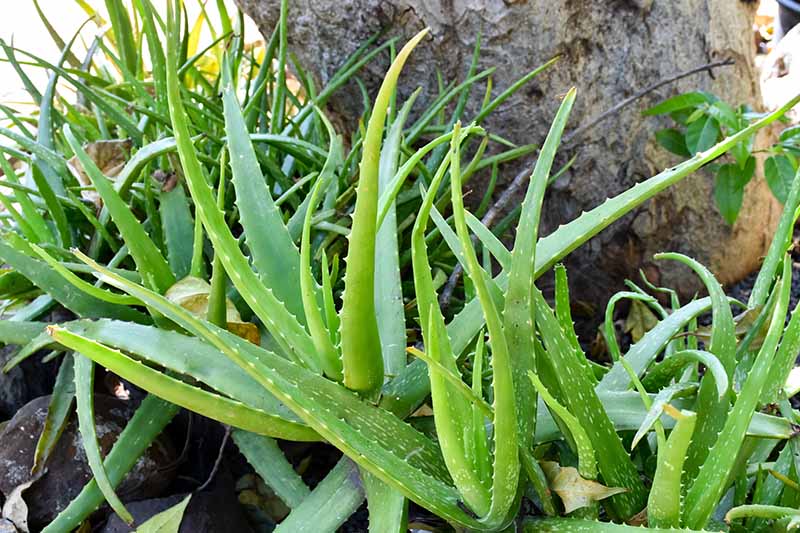
After light requirements, consider the soil you’ll be planting in. It should be loose and well-draining but it doesn’t need to be high in nutrients.
Look for a sandy, gravelly, or even rocky area. The last thing you want to do is give your aloe a home in a boggy area in soil that won’t drain, as this can contribute to root rot.
This succulent prefers a soil pH of 7.0-8.5, so you may want to conduct a soil test to see if the numbers fall within that range.
This isn’t strictly necessary, however, as it can adjust to slightly acidic soils if needed. If you want to increase alkalinity, you can add lime to the soil according to package instructions.
Once you’ve brought a plant home from a nursery or propagated a pup from a friend’s aloe, it’s time to put the succulents in the ground. Give them two to three feet of space between each other and any other plants in the area.
To transplant, dig a hole the same size as the container your aloe is currently growing in, gently remove it from the pot, and set it into the hole.
Backfill with soil and water thoroughly. When the plant is newly transplanted, let the top inch of soil dry out between waterings.
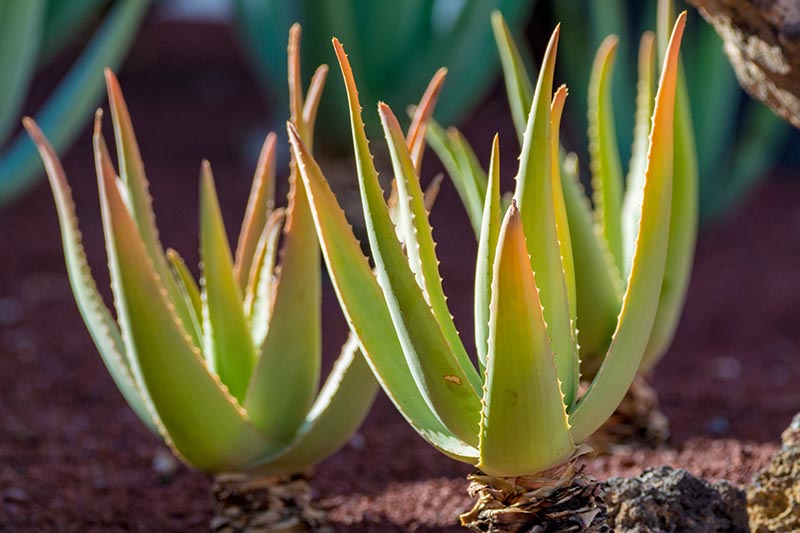
Once it begins to grow new leaves and thrive in its planting spot, you can slow watering down to about once every two to three weeks in the summer and once every four to six weeks in the winter, allowing the top two inches of soil to dry out between waterings.
Aloe vera doesn’t require regular fertilization, but if you want to speed up the growth rate a little bit or encourage flowers, you can fertilize it every six months with a 1-1-1 NPK fertilizer.
Keep in mind that the plant won’t produce flowers until it’s mature – at around four years old. In the meantime, keep it “pruned” by removing broken leaves whenever you spot them. It doesn’t hurt to harvest a leaf here and there to use on a sunburn, either.
When the plant is between two and four years old, you might notice that it’s growing lots of offshoots, or “pups.”
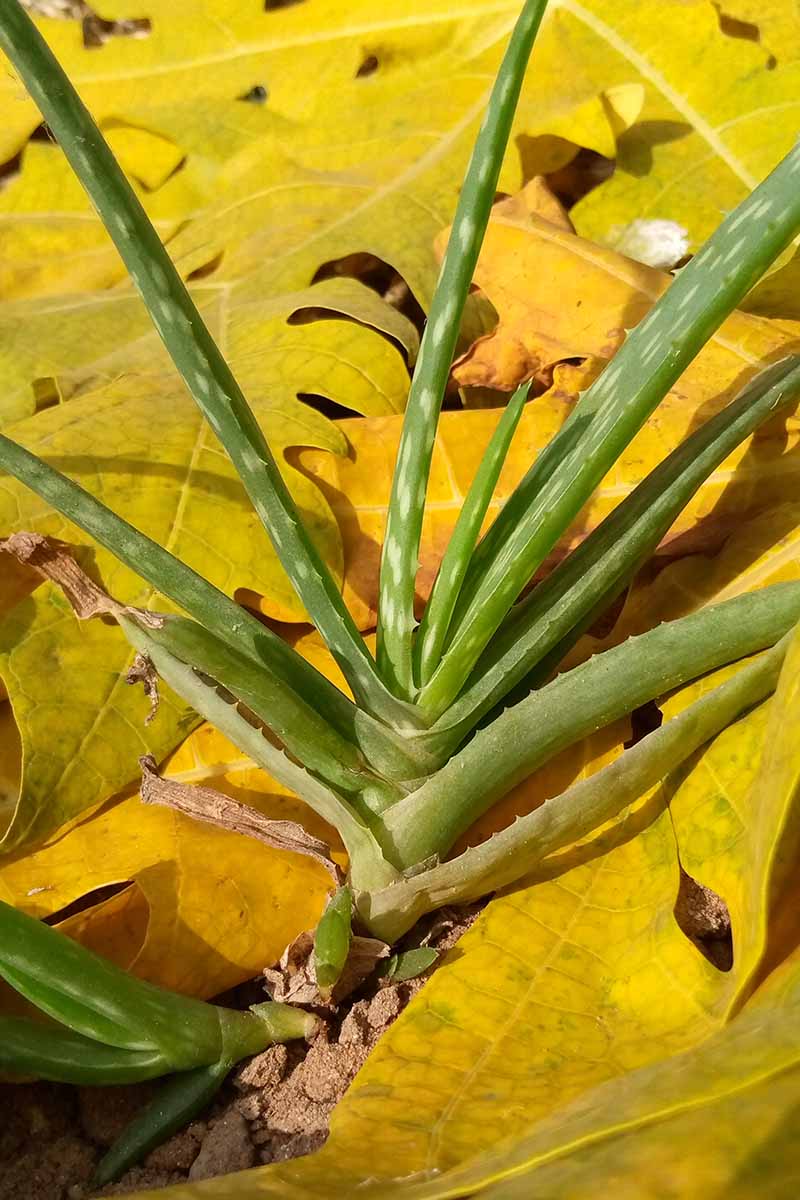
This is a good indication that the parent plant is ready for some division. To divide it, carefully dig the succulent out of its hole with a hand trowel. Brush away as much dirt as you can from the root ball.
You’ll see several pups growing off the main root system: each pup has its own stem, leaves, and root system that you can tease away from the parent plant. If the pups don’t come off with gentle disentangling, cut them off with a knife.
Place the parent back in the hole and backfill with soil. You can pot the pups in nursery containers with potting mix and give them away to your friends, or find places to plant them in your yard.
You can also start a window box or outdoor container garden with the pups.
Growing Outdoors in a Container or Window Box
The first thing to consider when choosing a container or window box is whether or not it has drainage holes. It’s easy to find containers that do, but it’s harder to find window boxes with them.
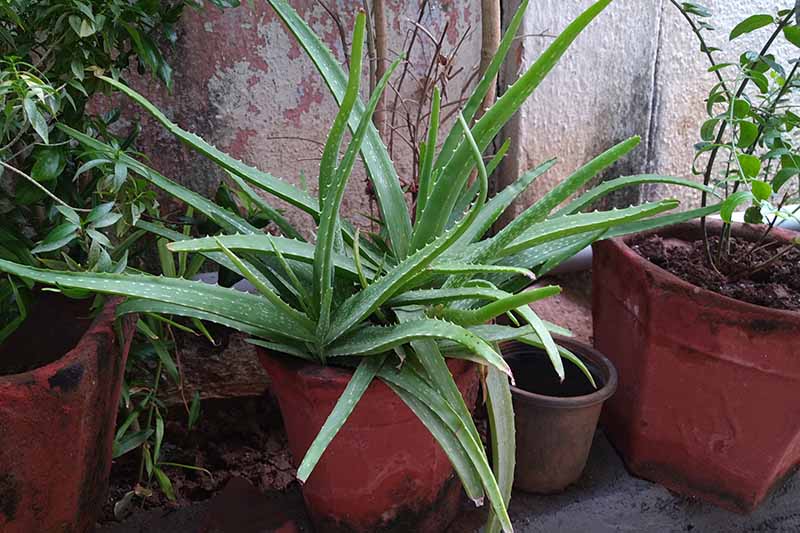
If you have your heart set on growing aloe in a window box that doesn’t have drainage holes, just drill three to four quarter-inch holes in the bottom of the box.
If you’re going to grow aloe in a container, choose a heavy one that won’t topple over with the weight of the long succulent leaves.
Miracle-Gro Cactus, Palm, and Citrus Potting Mix
Add a cactus and succulent mix to the window box or container, like this one from Miracle-Gro, available via the Home Depot.
Transplant the pups or potted plants directly into your containers or window boxes, burying them just enough so that the roots are covered. Water thoroughly, and you’re done!
Growing Tips
- Give your plant between four and six hours of full sun, depending on your area’s elevation
- Water once or twice a month, or when the top two inches of soil dry out
- Make sure the soil is loose and well-draining to help prevent root rot
Where to Buy
You can find potted plants at almost any time of the year in your local nursery or gardening store. I’ve stumbled across potted aloe vera in stores in January, even in frozen Alaska!
Aloe Vera Plants in 3.5-inch Pots
Or, grab this three-pack set of three-and-a-half-inch potted plants from Pure Beauty Farms, available online from the Home Depot.
Managing Pests and Disease
This succulent isn’t prone to pests and disease, but the few problems it does encounter range from mildly annoying to downright deadly.
Here are the main threats to watch out for when you’re growing this plant outdoors.
Pests
There are two main pests that may affect aloe vera outdoors: aphids and gall mites.
Aphids aren’t terribly problematic. They suck the sap from the leaves but it takes a long time for them to cause real harm. Spray them off with the garden hose and apply neem oil to the areas of infestation.
Aloe gall mites (Aceria aloinis), on the other hand, cause what’s informally called “gall cancer” in aloe vera.
The unsightly tumors look like warts and you might see them on the leaves, stems, and even flowers. These pests affect both commercially grown and homegrown aloe, particularly in southern California.
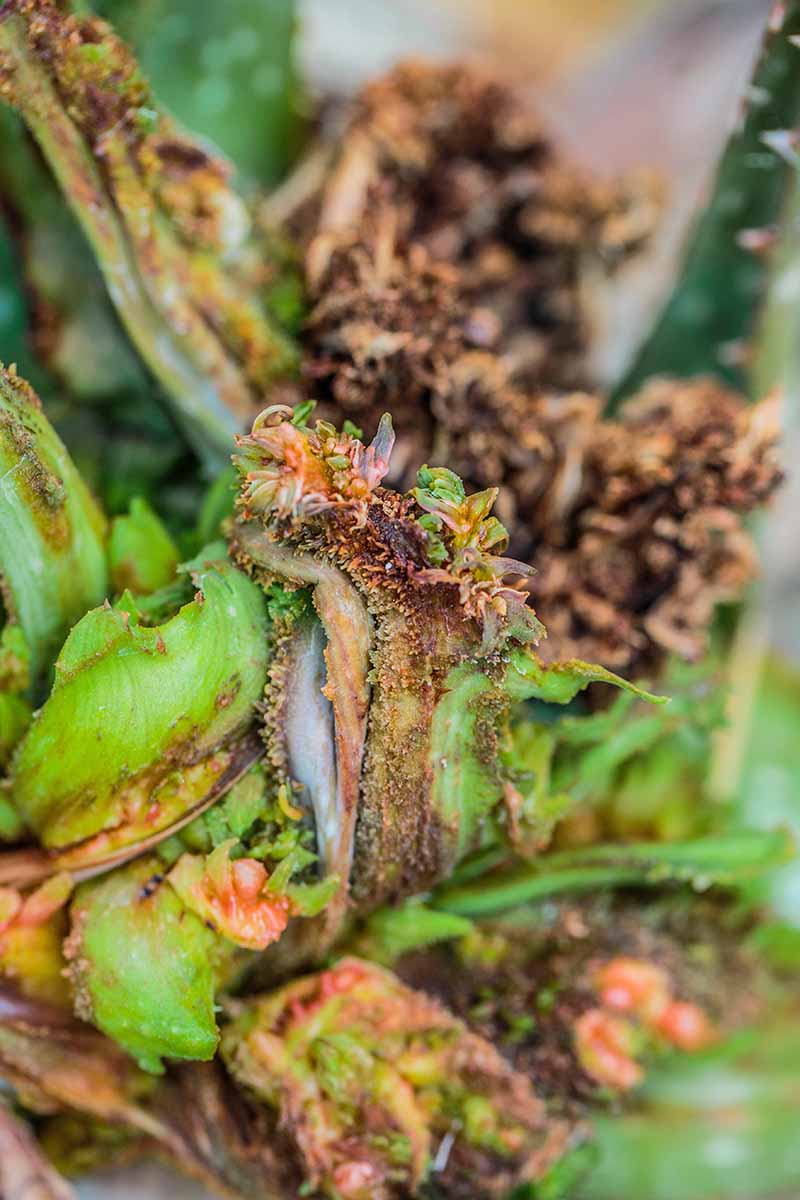
Unfortunately, aloe gall mites are microscopic and spread by wind, so you need to act fast if you have several plants but you only notice infection in one or two of them.
Remove the affected plant, seal it in a garbage bag, and throw it away. Spray the as-yet-unaffected aloes with neem oil or insecticidal soap and check them for damage every day.
Disease
Knowing what aloe’s most pernicious diseases look like can help you prepare to spot them early, clear the area of a deadly infection, and plant your succulents elsewhere.
Keep in mind that cultural controls, such as planting your succulents in loose, well-draining soil, can prevent these diseases in the first place.
The two most harmful – as in, deadly – are bacterial soft rot and basal stem rot.
Bacterial Soft Rot
Caused by the bacteria Pectobacterium chrysanthemi, bacterial soft rot is a problem associated with wet conditions.
Bacterial soft rot is typically a problem when hot weather is combined with wet soil. It mostly affects plants that are grown in waterlogged conditions, so make sure you choose an appropriate location and be sure not to overwater.
The leaves may develop bulging spots, or turn dark and shrivel.
This is a fatal disease and the bacteria can survive indefinitely in soil and debris, so remove the dying plant and all its detritus.
Refrain from planting any additional aloes in that location for three years and keep a close eye on any neighbors to see if they develop the disease, too.
In the case of container-grown plants, discard the plant and the soil, and be sure to sterilize your pot before reusing it.
Basal Stem Rot
Aloe vera prefers dry, warm conditions, whereas wet, boggy conditions can cause problems.
Basal stem rot, a fungal infection caused by several species of Fusarium, does exactly what its name suggests, rotting the stems of plants. The fungus favors damp, cool conditions.
If you notice reddish-black sections on the stem, this is a sign that the disease has taken hold, and the plant is a goner.
But if it has any pups, you can separate them from the mother plant, and check them for signs of rot. If they look healthy, plant them in a site with better drainage, or pot them up and place them in a drier location.
Best Uses
In addition to making an excellent addition to an outdoor window box, foundation planting, xeriscape, or container garden, this succulent is lovely for cooling minor burns or soothing itchy bug bites – a plus in warmer climates where the potential for sunburns and pest problems may exist year round.
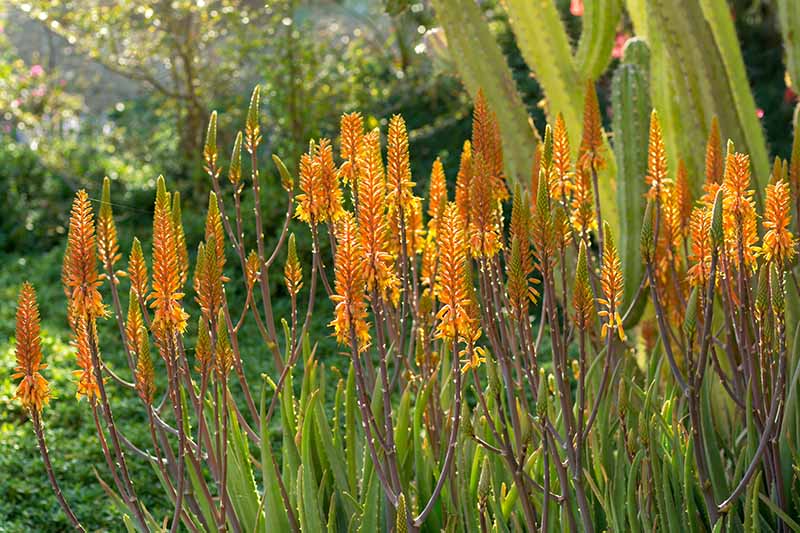
You can also grow aloe with other succulents and cacti as part of a defensive planting.
I particularly enjoy planting it window boxes outside my home for the summer – but here in Alaska, I have to bring them indoors during the cold months.
To plant it in window boxes for a pretty accent that’ll make your home stand out, try these self-watering ones from the Home Depot.
Fuss-Free and Fabulous
This succulent practically takes care of itself once it’s established. If you’re a busy gardener who doesn’t have scads of extra time to tend to demanding plants that wilt in the heat, aloe vera is your friend.

Are you growing aloe vera outdoors? Let me know in the comments section below and feel free to share a picture!
And for more information about growing aloe plants, check out these guides next:
- How to Grow and Care for Variegated Tiger Aloe
- How to Grow Christmas Carol Aloe: Anti-Sting and Makes You Sing!
- How to Grow and Care for Lace Aloe
© Ask the Experts, LLC. ALL RIGHTS RESERVED. See our TOS for more details. Product photos via Home Depot, Miracle-Gro, and Pure Beauty Farms. Uncredited photos: Shutterstock. With additional writing and editing by Allison Sidhu and Clare Groom.
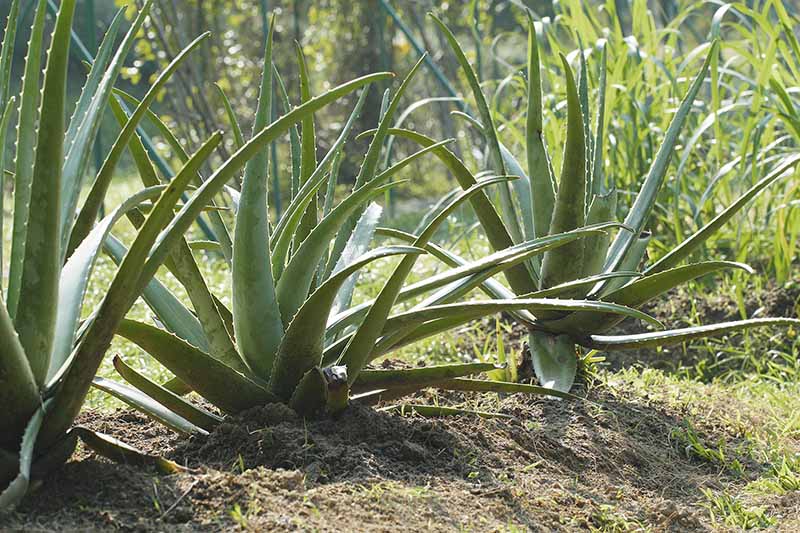

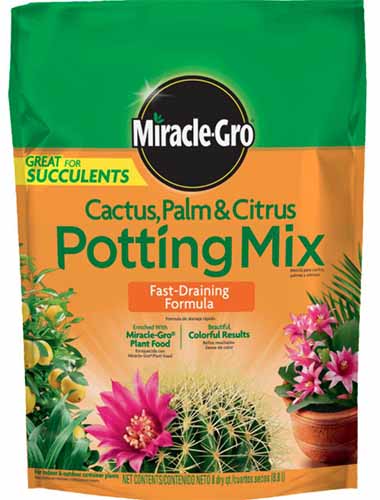
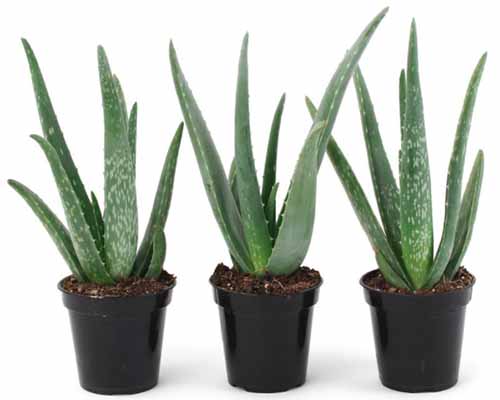

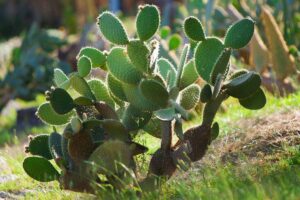
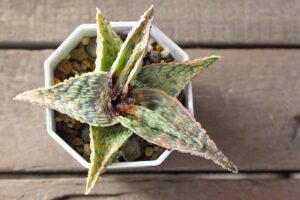
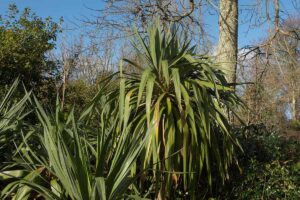
Hi I live in the uk and have an aloe which is quite on the large side and kept in my potting shed ????. I’m wondering if I could plant it in my garden? I have a nice sunny spot which is very gravelly what do u think ?
Hi Tracey! Do you happen to know what growing zone you’re in? I know the UK is generally within USDA Hardiness Zones 6-9, and if you’re in 8 or 9, you can definitely plant your aloe outdoors.
Hello, I planted three aloe veras in my garden about 5 years ago. They have grown quite a bit and I never knew I could separate the pups from the mother plant and as a result they are all quite overgrown and getting way too big. It is possible to separate them now or would I have to start with new plants? Thanks!
You can definitely take pups from mature, healthy plants! Just use a sharp, clean knife to carefully separate the pup and its roots from the mother plant, and you’ll be set.
I live in South Carolina in the Ladson area. My dad planted my aloe outside without me knowing it. Because it got big I wonder if it’s safe to be out during the winter. Right now it’s summer.
Hello Myra! As close as I can tell, you are in Zone 8b, which is a little cool to reliably grow aloe outdoors all winter. You can definitely keep a close eye on it and use a row cover ahead of freezes to protect it outdoors. I would strongly recommend digging up at least part of it to move to a container. The directions for dividing even a large aloe plant are in this article. If you have a container-grown aloe, you can move it indoors at the first sign of trouble. You can take both approaches at the same… Read more »
Don’t think its doing so good since my dad planted it
It won’t let me put a picture of it but I think it’s dying. Bottom leaves dying.
I am sad to hear that. But if part of the plant is still alive, I would try to divide it or dig it back up and put it into a pot for the future. Aloes are usually pretty tough and it might make a comeback, just not outdoors in too-cool of weather.
Had my dad dig it up and put it in a bigger pot and bring it indoors and cut off the dead leaves. It’s doing a lot better now.
Hooray! Thanks for getting back to us with a success story.
Hello , just bought an aloe Vera plant from the store in a container . We live in zone 9b almost 10. I want to plant outside . Do I need to harden it before planting or can I just plant it outside now ?
Hello Dawn Navarrette.
You’ll be glad you did if you take about a week to get it accustomed to the higher temperatures and most especially the brighter light of the outdoors compared to the interior of a store.
Would love to see photos as it gets growing, if you get a chance. Good luck with this aloe adventure.
Have a Aloe Vera Plant in very hot desert, 110-120 degrees in summer. Last year in had hunderds if dead leaves all around when I purchased the house. Removed all the dead leaves to fine a few still alive. after watering it every day it began to thrive, but in the heat of summer if is beginning to turn brown on th outside. Right now it is seeing 115 degrees daytime, night 90’s with about 14 hours sunlight. Am I killing it?
Hello Russell Harrison! Those are some drastic growing conditions and I’m glad you were able to bring your plant back to life! As for those newly browning leaves, it sounds too me like your aloe are getting too much direct sun. They thrive with 4-6 hours of direct sun each day, but need less in the type of growing conditions you’ve described. It might be time to invest in some shade cloth for the harshest months of heat. And once the heat has abated a bit, you might want to transplant the aloe to a more hospitable part of your… Read more »
Hello, I didn’t even know Aloe plants grow like this. Great surprise. Is it too late to divide them to separate pots? I live in a tropical island.
Hello Elena! I agree, the prospect of growing aloe outdoors is wonderful, especially when they get so large. As for dividing the plants, it’s probably not too late if you live where it’s warm all year ’round. But you will want to make sure the pups are at least a third the size of the parent plant, and take care to keep them moist but not wet until they get established in their new pots. If it’s scorching hot right now, consider moving the newly potted plants where they’ll be shaded part of the day or even indoors if that’s… Read more »
Hi! I have a small outdoor garden of aloe vera. They’re all looking healthy and absolutely beautiful. But my babies (my aloe plants) are not growing in length. They’re definitely spreading but they’re all short and skinny and I feel like I’m doing something wrong. I initially planted them to use on my hair but they’re not long and big enough for that purpose. Can you help me?
Where are you located Michelle, and are you positive that you are growing aloe vera? Other varieties of aloe may be shorter in stature. Maybe you can share a photo, and walk me through how you care for your plant babies? Since you say they’re looking healthy otherwise, I wonder if overcrowding or a lack of certain nutrients may be the issue. If the leaves were skinny and brittle rather than plump, inadequate watering may be the culprit. Make sure the soil is well-draining, not compacted, and consider dividing and replanting if overcrowding may be an issue. Water deeply when… Read more »
Thanks for replying.
It seems like I cannot attach images to my comment. I live in Lagos, Nigeria. My babies are about 1 1/2 or 2 years old. I don’t really do much because I don’t have the resources to take care of them properly, as you can see I don’t even have a proper pot. And I divide and replant if I notice that their overcrowded.
I used image search and yeah, they are Aloe Vera.
Hi Michelle, I’ve managed to retrieve your image as it uploaded but didn’t attach.
Hi Michelle, we were able to retrieve your photo. This looks very healthy to me! The leaves look plump and straight, and I don’t know that they are going to get much wider than that.
Any type of container is fine, as long as it has drainage holes in the bottom. The pup can be divided and repotted. Ensure that your plants are getting adequate sunlight, and be sure to water deeply when the soil feels dry a few inches down so the excess runs out the drainage holes in the bottom of your container.
Hi
Just purchased a home in St Augustine, Florida and there are several sections of aloe that look like this. Should I transplant some of the plants, they seem very crowded together? Thank you for any help/suggestions Rosemary
I was able to retrieve your photo, Rosemary.
This looks like a thriving aloe colony! You can certainly transplant or divide pups to make more room for the plants to grow and spread.
Excited to learn about you folks
I’ll have many questions going forward.
For now I was wondering if it’s ok to take my aloe plants outside for the summer. We live in SW Wisconsin.
Glad you found us, Mike. Yes, absolutely! Just make sure you keep an eye on the weather, and plan to bring your plants back inside again long before the temperature takes a nosedive. It’s usually best to harden off plants that have overwintered indoors to outside conditions gradually, exposing them to outdoor temperatures and sunshine on a warm day for about an hour and then bringing them back inside. Increase by an hour each day for about a week until your plants can stay out full time. When you bring your plants back in, check for signs of pests –… Read more »
These are in the garden of the place we just bought. I’m in zone 9b it gets very hot. Both plants have bloomed (one bloomed twice). They are planted very close together. I’m not familiar with how to care for them and want to manage the rust problem. I need help. The temps are in the high 90’s with heat index 106-110 today and we aren’t in the hottest time yet.
Sorry your picture failed to upload, Marlyn. Please feel free to try again! Rust in aloe can be managed with copper fungicide, which you can read more about in this guide. Fortunately rust infections are not fatal – as new growth appears, you can discard the affected older leaves. Hotter temperatures like you described actually help to slow or prevent the spread of rust. You may want to transplant if these are overcrowded, as a lack of airflow combined with moisture on the leaves can lead fungal issues to develop in the first place. If you need to provide supplemental… Read more »